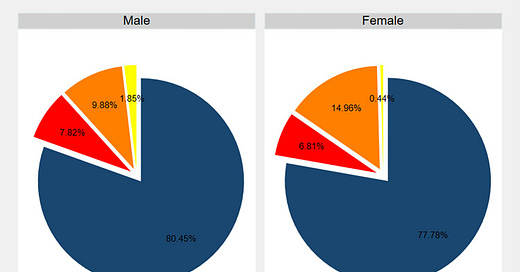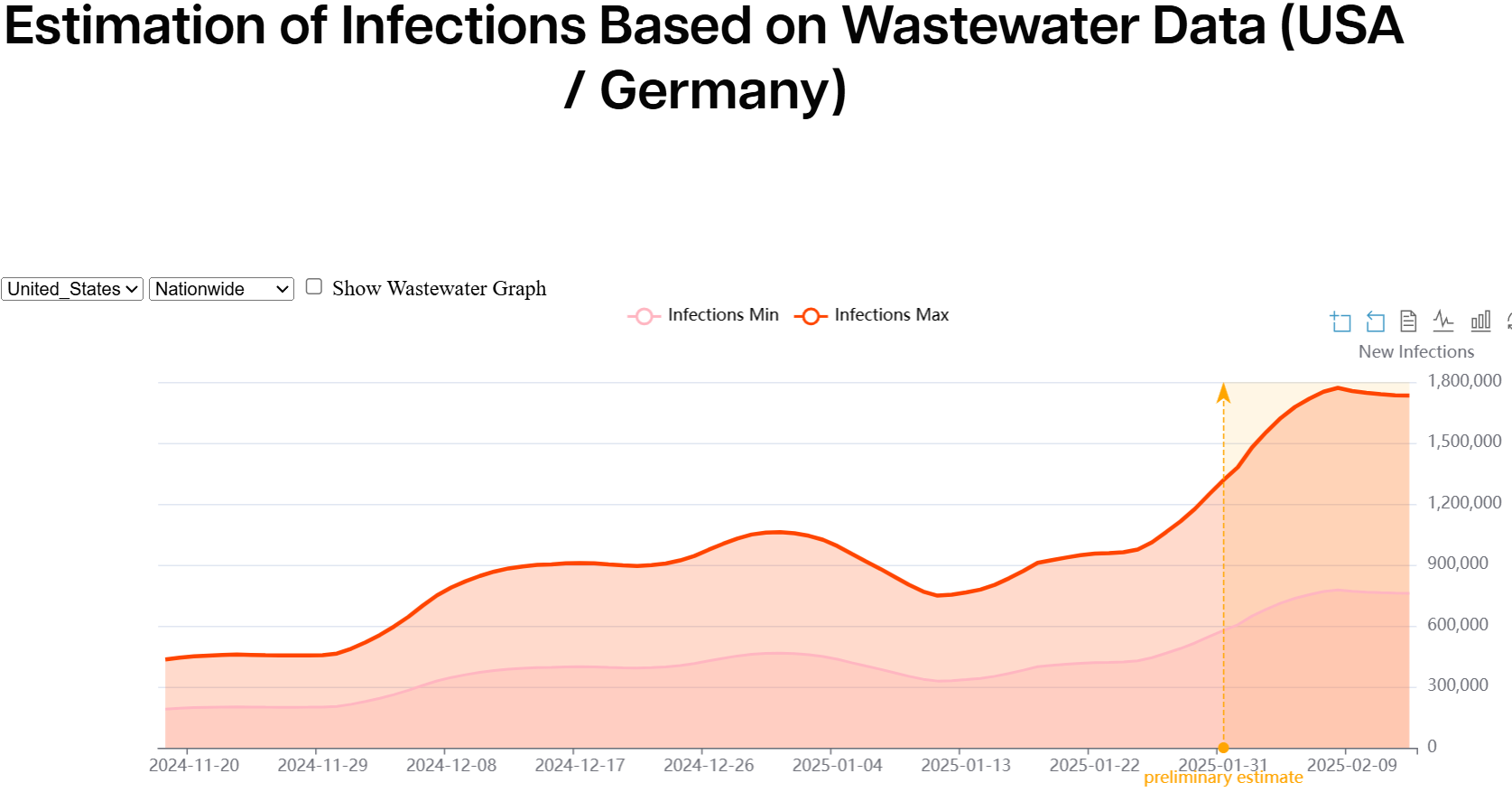Pathogen Update: 2-18-2025 Forecast Edition
New Forecast, SARS-CoV-2 and our future and H*N* updates
Do you think it is way past the time when women should be at the top of our governments, or are you happy with the way a largely white and older male generation has been doing? Read more in And now for something completely different …
If you care as much as I do about Long COVID, the following should assist you in helping out the cause. Long Covid Awareness Day is quickly approaching. I will have a guest writer, Becky Robertson, produce a special substack this weekend. Becky, a dear friend, co-hosts a nightly open space on X with me. She has had an extraordinary journey as she navigated life with Long COVID through all the pitfalls it manifests while still being a tireless advocate for the cause. Her story is truly inspiring to many, including myself.
Last Monday, my friend Matt McNeil interviewed me on, what else, The Matt McNeil Show. Instead of giving you a written section on the current influenza and H5N1 situation, I will defer to this recording, where you can hear my thoughts and assessments on those pathogens. This will allow me to get this forecast out in a timely manner. I promise I will write about the situation in a future newsletter.
MAPS
I continue to refine the new initialization methodology for the MAPS model. I have also added Influenza to the list of modeled pathogens. This includes predicting coinfections with SARS-CoV-2 that produce more severe outcomes. I will include influenza forecasts soon to address an ever-increasing concern over the trajectory of influenza infections. So, as of now, MAPS can simulate SARS-CoV-2 and its variants, measles, influenza, and a hypothetical human-to-human H5N1.
The wastewater data used to derive New Daily Infections (NDIs) and initialize maps is finally catching up to current values after the freeze imposed by the current administration. The last date that our WHN data meets our quality control is January 31, extending to February 13 for preliminary estimates. The present forecast extends from January 31 through May 30. The variants used in the forecast are from the CDC variant proportions analysis from February 2-15 and are shown in the table below the current wastewater data graph of NDIs.
The graph of NDIs shows that the readjustment of past values extends back into December. Note that the early January peak has been reduced by over 300,000 NDIs, and it appears that we have passed through an even larger secondary peak, eerily similar to last summer's double peak. This is in contrast to previous years, which indicated a rapid drop after the post-holidays peak. I will have more on this in the future.
The table of wastewater variant proportions indicates the continued decline in XEC dominance and the rise of LP.8.1, which I will surmise is currently the most predominant variant as of this writing. I want to point out that 4 out of the top 10 variants are recombinants. Back in August, I pointed out that the next phase of dominant variants after the run of the JN.1 variants would be recombinants. Whether this persists is of considerable interest but does fit the pattern of the emergence of recombinants (XBB*) after the BA.2 variants dominated for nearly a year.
The following graph shows the mean and +/- 95% confidence limits for the MAPS Ensemble (N=20) forecast from January 31 through May 30 of 2025.
The plot indicates that we have just gone through the secondary peak, which the current wastewater data suggests is around 1.8 million NDIs. Remember what happened? As I pointed out earlier, the early January peak was adjusted downward by over 300,000 NDIs. The decline should continue for the rest of the month, at which point the NDIs will start to increase again over a 2-month period, reaching a peak around early May of nearly 1.7 million NDIs. Over this period, MAPS totaled 125.2 million infections, resulting in between 6.8 and 31.1 million Long Covid outcomes. Do you see a recurring result happening in these forecasts? Nearly every forecast I have produced over more than a year has indicated that at least one-third of the population is infected, whether it be a new or multiple infections during this period. Folks, as I tirelessly have pointed out, this is not sustainable for our health or economic interests.
If continually linked to repeated SAR-CoV-2 infections, our future is also perilous: co-infections. My good friend Emmanuel outlines a taste of this future, which should raise many alarms.
Primary CONCERN for the FUTURE : CO-INFECTION
(Mega-thread🧵 with more than 20 studies)
SARS-COV-2 and Staphylococcus aureus, Influenza, Chlamydia pstittaci, Mycobacterium tuberculosis, HIV, Kaposi's Sarcoma Virus, Tocoplasma Gondi, Adenovirus, Valley fever, Dengue, Measles ...
Here is a list of studies he covers on co-infections.
SARS-CoV-2 INFECTION PREDISPOSES PATIENTS to COINFECTION with STAPHYLOCOCCUS aureus
BACTERIAL CO-INFECTION in COVID-19: a call to stay vigilant
"Opportunistic infections changed before and after SARS-CoV-2 infection in inflammatory bowel ..."
2 examples, 2 studies just published : COVID-19 and TOXOPLASMA GONDII / ACINETOBACTER BAUMANNII
"Developing a Coccidioides posadasii (Valley fever) and SARS-CoV-2 Co-infection Model ... "
And from 2023 : SARS-COV-2 and Dengue, Malaria, Measles, Fungus, Parasites
Please spend time reading his summaries and think about the potential this has for our future.
A Brief H*N* update
And now for something completely different …
The outbreaks have led to the loss of more than 162 million birds across all 50 states, which is roughly 19%, 641 counties, 1572 confirmed (first map). The situation concerning wild birds is in the right-hand map. Wild Birds 11966 detected in over 1220 counties.
972 dairy herds across 17 states have tested positive
Minnesota to start testing milk for H5N1
Advected through the atmosphere, more on this at the end
Third avian flu (D1.1 adapted to cattle) spillover reported in Arizona dairy herd; raw pet food sickens Oregon cats
New Jersey-based Zoetis, on February 14, announced that the USDA’s Center for Veterinary Biologics has conditionally approved a license for the company’s killed-virus H5N2 avian flu vaccine for use in chickens.
APHIS confirmed more H5N1 detections in poultry in four states, including Indiana. Two more large outbreaks occurred at layer farms and events at a turkey farm and a backyard facility. The virus was also confirmed at turkey farms in Iowa and Ohio and at a commercial farm in California.
68 people have been infected with H5N1 bird flu. In 63 of those cases, workers picked up the virus while working with infected animals; 40 got it working with dairy cattle, and 23 with infected poultry. In three cases, the source of exposure was not determined. In one case, a person got it from handling sick or dead birds in a backyard flock. That person died.
Japanese encephalitis virus detected in Goulburn Valley pig herd. There is a human vaccine for this
As was just mentioned, H5N1 is absorbed through the atmosphere. I posited this idea several months ago while talking with other colleagues. My idea was to put a simple dispersion model in the MAPS and farm locations and advect the H5N1 source, employing the atmospheric data I already use in the model. Furthermore, I indicated that some unexplained outbreaks could be caused through this pathway. I was met with some skepticism.
Here is a study that basically proves this mechanism through a real-world example.
Genetic data and meteorological conditions: unravelling the windborne transmission of H5N1 high-pathogenicity avian influenza between commercial poultry outbreaks
Understanding the transmission routes of high-pathogenicity avian influenza (HPAI) is crucial for developing effective control measures to prevent its spread. In this context, windborne transmission, the idea that the virus can travel through the air over considerable distances, is a contentious concept and, documented cases are rare. Here, though, we provide genetic evidence supporting the feasibility of windborne transmission. During the 2023-24 HPAI season, molecular surveillance identified identical H5N1 strains among a cluster of unrelated commercial farms about 8 km apart in the Czech Republic. The episode started with the abrupt mortality of fattening ducks on one farm and was followed by disease outbreaks at two nearby high-biosecurity chicken farms. Using genetic, epizootiological, meteorological and geographical data, we reconstructed a mosaic of events strongly suggesting wind was the mechanism of infection transmission between poultry in at least two independent cases. By aligning the genetic and meteorological data with critical outbreak events, we determined the most likely time window during which the transmission occurred and inferred the sequence of infected houses at the recipient sites. Our results suggest that the contaminated plume emitted from the infected fattening duck farm was the critical medium of HPAI transmission, rather than the dust generated during depopulation. Furthermore, they also strongly implicate the role of confined mechanically-ventilated buildings with high population densities in facilitating windborne transmission and propagating virus concentrations below the minimum infectious dose at the recipient sites. These findings underscore the importance of considering windborne spread in future outbreak mitigation strategies.
This is not rocket science, and it needs to be done. I already use this data. I hope to build a system similar to the global weather analysis and forecast systems within the next year. It would display real-time data, alerts, and forecasts.
Finally, there are numerous vectors for this pathogen that have enabled its spread locally, as well as globally. As a bird lover, I urge, and it pains me, not to put out bird feeders this year. You are putting yourself and your pets at risk by inviting our avian friends to poop in our nearby vicinity. And speaking of pets, you must watch them closely as migratory birds return this fall. Other sources include other mammals in your vicinity, such as rodents. You thought SARS-C0V-2 was intimidating, but H5N1 poses many more possible risks to us all and will likely come with a staggering mortality rate when it goes human to human. Notice I said “when” and not “if.”
Brief InfluenzaUpdate
Overall activity is high for respiratory illnesses
Emergency room/hospital activity: RSV Moderate, Covid low, Influenza Very High
Wastewater: Covid High, Influenza Very High, RSV low
Xofluza (Baloxavir) is a new treatment that is better than any others but is not widely known about
We can see that influenza is undergoing a secondary surge in the graph below.
After talking with numerous medical staff, there is a consensus that this flu season is worse than what they experienced.
And now for something completely different …
Judging by the way we select our leaders, you might want to reconsider continuing to vote for largely older, white male leaders … not that many of us did not already know this.
'Dictator Game' experiments show women are more generous than men
A group of psychologists and economists at Jaume I University, in Spain, has found evidence that women are more generous than men. In their study published in the open-access journal PLOS ONE, Iván Barreda-Tarrazona, Ainhoa Jaramillo-Gutiérrez, Marina Pavan, and Gerardo Sabater-Grande conducted experiments with volunteers playing "the Dictator Game."
Prior research has suggested that men and women are nearly equal regarding financial generosity. But the team noted that virtually all such studies have involved small numbers of volunteer participants. In this new work, the group attempted to learn more about gender-based generosity by recruiting 1,161 volunteers to play the Dictator Game, and used the results to measure generosity.
The Dictator Game is a type of ultimatum game developed by psychologists to determine if people act solely out of self-interest. Players are given a certain amount of money and are asked if they would like to share some or all of it with a second, anonymous player. The second player is at the mercy of the first; they will receive only the amount offered by the first player.
For this new study, the researchers ran the same experiment several times, once in each of the years 2020, 2022 and 2023, for a total of 1,161 male and female players—every time, the first player was given €10 and then asked how much, if any of it, they would like to share with a second unknown, randomly selected second player.
The research team then tallied up the results and compared them by gender. In looking at the data, the group was surprised to find that women were far more likely to give some of the money to the second player. The players were also paired with a different person when it came time for them to take on the role of the second player; therefore, no reciprocity was involved.
The researchers found that women gave away 40% more money than men. The researchers also asked each of the players to first fill out a personality profile—they found that people who were gauged as more open and more tolerant were more likely to give more. They noted that women with stronger reasoning skills were more likely to give less than other women with weaker reasoning skills.
They also acknowledge that generosity was measured in a constrained environment; thus, it is not known if such gender differences exist where people know those who might be receiving the money or when others might be watching to judge them.
Here is a link to the actual study.
Stay safe, and do kind acts for others and, most of all, yourself. Thank you for reading.
Joe
Miscellaneous items you might like follow below.
Here is a kick-ass at-home test, nearly equivalent to a PCR test.
SARS-CoV-2 is a vascular virus, not just a respiratory virus. To make it simpler for folks, call it a whole-body virus. No organ is spared. It infects our entire body and creates reservoirs throughout. It should be thought of as a Long COVID virus and will exploit pre-existing risk factors.
Interviews Dr. Michael Hoerger, Dr. David Joffe, Emmanuel Justin, and Dr. Yaneer Bar-Yam.
Check out this article. I love it. It’s an easy read but stimulates the brain in many ways.
Viruses Finally Reveal Their Complex Social Life - Quanta Magazine
Where do viruses hide in the human body? | The BMJ
Understanding immunity and viruses through the John Snow Project
Variant tracking at the CDC
Infections at WHN (updated!)
The neuroinvasiveness, neurotropism, and neurovirulence of SARS-CoV-2: Trends in Neurosciences (cell.com)


















I should have included the the prior two weeks; I consider them "spin-up", but you see a short lived peak right at the beginning. I will treat them both ways.
This sequence data feed is pathetic. We got a little hint of a D3 subtype in some data from Wisconsin that might be fueling this.
Thank you for your thoughts and input.
Joe
"The plot indicates that we have just gone through the secondary peak..."
Actually, YOUR MAPS Ensemble as presented HERE does NOT show this, although it appears to be the case based on other sources. In the future, are you planning to break out SARS-CoV-2 and Influenza SEPARATELY or combine them into an omnibus infection graph?
It seems 'curious' that very little sequence data from human influenza cases are being publicized.
However, recent actions by the states mandating subtyping of influenza cases where bird flu is suspected seems to fit the old adage of "Watch what they do, not what they say"
Rather discouraging that we are about to enter another SARS-CoV-2 wave, but it's better to know than not to know. In this age of disinformation, thanks for providing situational awareness to those of us who want the straight scoop.